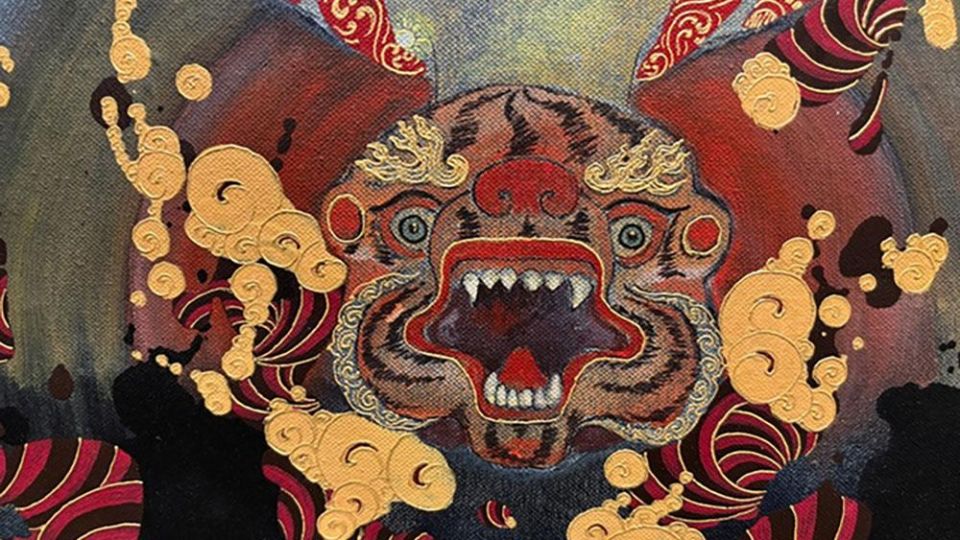September 18, 2025
NEW DELHI – Known simply as Tintin, he has emerged as one of the leading figures in Bhutan’s contemporary art movement, blending Buddhist iconography with modern visual language. His new exhibition, which runs until October 7, invites viewers into the layered spaces of the bardo—the Buddhist state between death and rebirth—as well as into dreams, illusions, and the present moment.
Born in 1985, Tintin has built a career across multiple media, including painting, sculpture, film, illustration, and design. His practice often interrogates the notions of self and non-self, charting the emotional and spiritual journey of life through creative expression. What distinguishes him is his reinterpretation of tantric Buddhist symbols: respecting tradition while pushing the boundaries of how these symbols can be understood in a contemporary world.
For Tintin, art is inseparable from life itself. “It is not about tension but more about harmony,” he explained when asked how he balances Buddhist philosophy with artistic interpretation. “The core essence of Buddhism is finding the truth. I use art as a medium to understand life, to show why we exist and the truth behind life.”
This approach shapes the works in In Between Dreams, many of which take the form of traditional thangka paintings, complete with silk brocades, veils, and borders. Yet Tintin allows his compositions to spill out of these frames, breaking through their boundaries.
“As a Buddhist and a Bhutanese, we understand our tradition the most,” he said. “The thangka is not for decoration. It is believed to be a gateway to Dewachen, a higher realm. My intention is to emphasise that essence, and I am glad it worked out for the exhibition.”
The exhibition also pays homage to great adepts like the mahasiddhas and Guru Rinpoche. For Tintin, the mahasiddhas—enlightened beings who attained realisation through unconventional practices, often in artistic forms—are a constant source of inspiration.
“They are proof that artistic values can be divine,” he said. In this series, he integrates twelve astrological masks representing the living, weaving them together with the presence of the mahasiddhas. “The masks signify everyone who is alive, everyone who is existing. By connecting them with the mahasiddhas, I hope everyone can relate and draw inspiration.”
Tradition, however, is not something Tintin sees as fixed.
“We are born in a world of symbolism and we have more respect for it,” he reflected. “But a culture that doesn’t grow is dead. I want to give new meanings to old symbols, while respecting and treasuring the old ones.” Innovation, for him, is essential to keeping Buddhist visual culture alive.
His works also invite viewers to inhabit an “in-between” state, where time itself seems to collapse.
“Each and every one of the viewers will carry something different,” Tintin said. “I hope they understand Buddhist philosophy more—the illusionary life, the concepts of life, birth, and death, and the experiences we go through daily.”
Art historian Dr Ariana Maki, a specialist in Buddhist art and architecture, observed how Tintin’s paintings position viewers in unfamiliar surroundings, compelling them to consider existence across past, present, and future simultaneously.
She noted that his works capture both the persistence and trust at the heart of Buddhist practice, revealing how the bardo recurs within the cycles of samsara. By weaving in masks and swirling, reflexive forms, Tintin’s paintings acknowledge suffering while illuminating transcendence, embodied in figures such as the mahasiddhas who broke free of the cycle.
Elena Pakhoutova, senior curator of Himalayan art at the Rubin Museum of Art, highlighted the duality of mastery and experimentation in Tintin’s practice. Created between 2023 and 2025, these works draw on the Tibetan Buddhist teachings commonly known as the Tibetan Book of the Dead.
She described how Tintin carefully employs pigments, integrates thangka structures, and at the same time subverts hierarchies to create new personal meanings. For her, each painting beckons viewers toward recognition of the familiar while encountering something entirely new.
This dual movement—anchored in Buddhist tradition yet reaching for contemporary expression—sits at the heart of Tintin’s art. His work is less about instruction than invitation: “I am not there to preach, but rather encourage the understanding of Buddhist philosophy.”
Providing the platform is Gallery Threshold, an institution that since 1997 has built a reputation for thoughtful, research-driven exhibitions. Founded in Visakhapatnam and relocated to Delhi in 2003, the gallery has spent more than two decades championing both established and emerging voices in Indian and international art.
In hosting Tintin’s Indian debut, it extends its mission of nurturing artistic talent while fostering deeper conversations around tradition and transformation.


